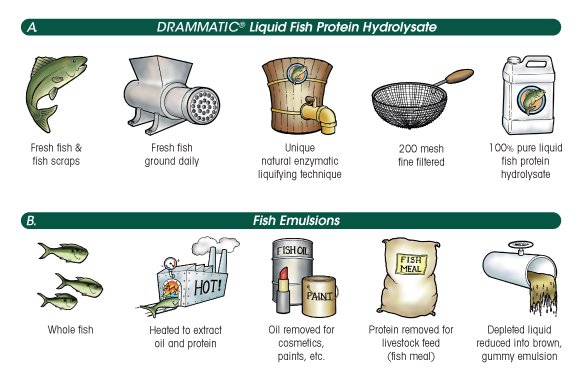The Power of Fish Fertilizer in the Orchard
Holistic orchardists highly recommend the use of organic fish fertilizer in an orchard. In this blog, Casey Schoenberger, Director of Sales for the Farm and Fertilizer department of Dramm Corporation, breaks down how fish fertilizer is made and why it is important. If you enjoy this blog, consider subscribing to The Serving, Giving Grove’s quarterly newsletter.
Contributed by Casey Schoenberger
Over 20 years ago, Kurt Dramm (son of Dramm Corporation creator, John G. Dramm) began using fish hydrolysate fertilizers, created from the fishing industry’s waste, in his own greenhouse and was amazed by the results. He was compelled by the opportunity to offer high-quality, easy-to-use fertilizers to his customers while also helping to solve an environmental problem. Dramm decided to begin manufacturing organic fertilizers and called it “Drammatic Liquid Fish Fertilizers.”
How is Fish Fertilzer made?
Dramm’s fish fertilizers are derived from fresh fish scraps from the Great Lakes which would otherwise fill landfills and overwhelm local wastewater treatment plants. After the filet of the fish is removed for human consumption, Dramm collects the remaining scrap. The scrap is ground up and enzymatically digested at low temperatures for months to break down solids into a liquid filtered through a 200 mesh screen prior to leaving the factory. The end product is pH stabilized for shelf stability and lasts for years undiluted. Not unlike canned vinegar-based pickles in your pantry.
Drammatic Liquid Fish Fertilizers contain the natural oils, amino acids, nutrients, and minerals found in the fish and specifically contain high levels of plant-available phosphorus and calcium. Though most fertilizers are purchased with the NPK (Nitrogen, Phosphorus and Potassium) in mind, many growers use Drammatic more as a biological food source. Fish hydrolysate fertilizers have an incredible ability to feed beneficial fungus and bacteria both in the soil and on the plant surfaces.
“By encouraging the growth of the “good guys,” you are enlisting your own army to fight off the pathogens that often thrive in sterile or unhealthy environments.”
Fish hydrolysate fertilizers have been used in a number of different ways in the orchard environment depending on what the grower is trying to accomplish. Though ground applications of diluted fertilizer to boost nutrient levels are common, the use of fish hydrolysates as probiotic foliar sprays is gaining in popularity. These applications are often done throughout the year as the liquid fish fertilizers are tank-mixed with other amendments.
Why You Should Use Fish Fertilizer in Your Orchard:
In his book The Holistic Orchard (Chelsea Green, 2011), the late orchardist Michael Phillips touts the many benefits of using fish fertilizers as a fall orchard spray. These include stimulating beneficial microbes to speed up decomposition on the orchard floor, providing nutrients in trees for winter storage to kick start spring growth, and replenishing the soil nutrient bank. In addition to fish fertilizers, Phillips’ spray program includes pure neem oil and effective microorganisms or compost tea.
Home orchardists will often use a 4-gallon backpack sprayer to apply their foliar sprays, but just about any sprayer will do the trick. Ground applications are often made by simply diluting your desired amount of fertilizer in a five-gallon bucket and applying as necessary. It is important to thoroughly clean all equipment after use as the same probiotic aspects that make fish fertilizer so effective in the orchard work against you inside equipment and drip lines. A good flushing with water of all lines and equipment is all that is needed, though some growers prefer to follow up with a safe cleaner.
Dramm Corporation of Manitowoc, WI has been providing home gardeners and commercial greenhouses with tools to make their jobs easier for more than 80 years. To learn more about Dramm and their line of consumer products, follow them on Facebook and Instagram.
The Giving Grove would like to thank them for providing fish fertilizer for the 2022 growing season.



